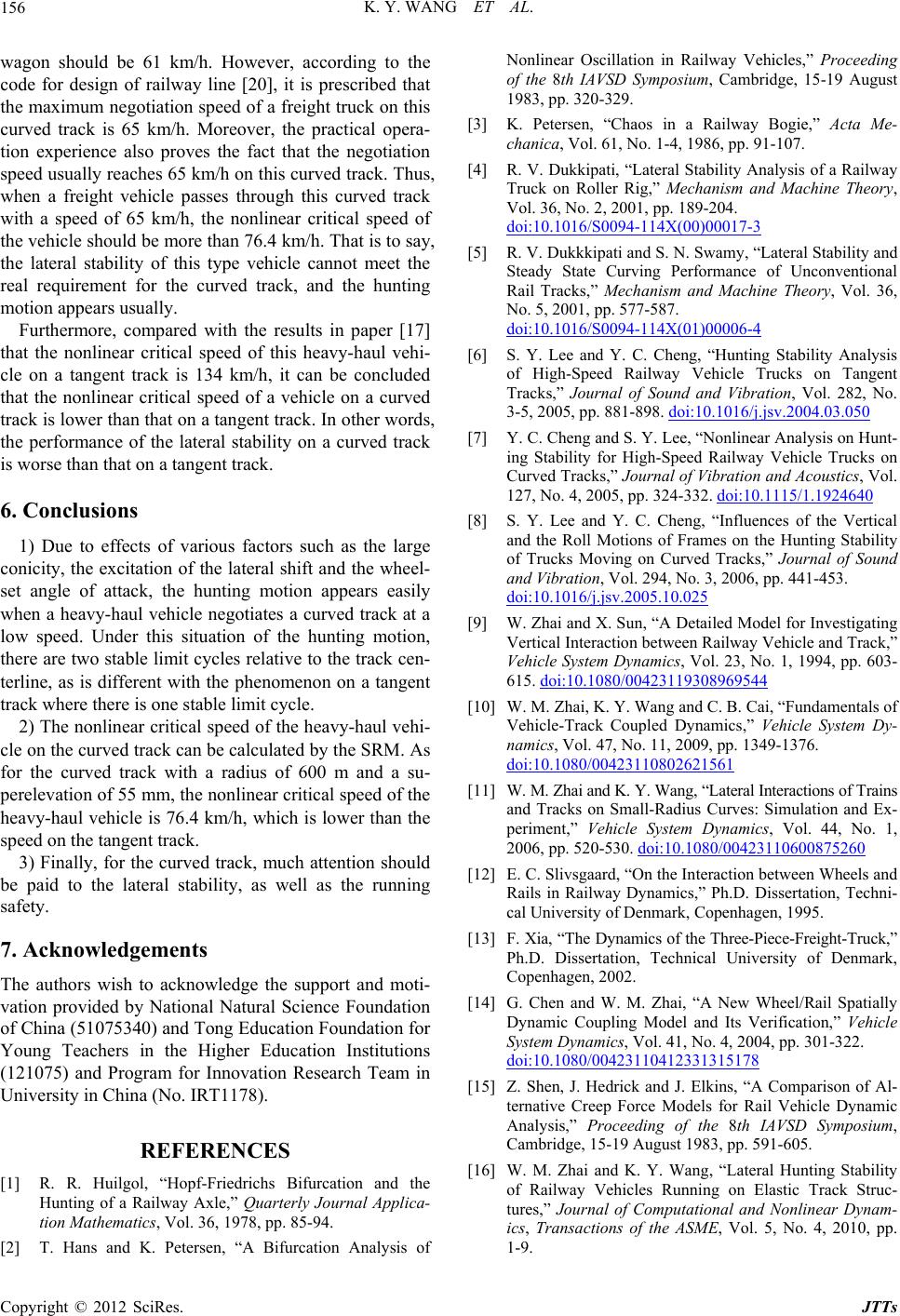
K. Y. WANG ET AL.
156
wagon should be 61 km/h. However, according to the
code for design of railway line [20], it is prescribed that
the maximum negotiation speed of a freight truck on this
curved track is 65 km/h. Moreover, the practical opera-
tion experience also proves the fact that the negotiation
speed usually reaches 65 km/h on this curved track. Thus,
when a freight vehicle passes through this curved track
with a speed of 65 km/h, the nonlinear critical speed of
the vehicle should be more than 76.4 km/h. That is to say,
the lateral stability of this type vehicle cannot meet the
real requirement for the curved track, and the hunting
motion appears usually.
Furthermore, compared with the results in paper [17]
that the nonlinear critical speed of this heavy-haul vehi-
cle on a tangent track is 134 km/h, it can be concluded
that the nonlinear critical speed of a vehicle on a curved
track is lower than that on a tangent track. In other words,
the performance of the lateral stability on a curved track
is worse than that on a tangent track.
6. Conclusions
1) Due to effects of various factors such as the large
conicity, the excitation of the lateral shift and the wheel-
set angle of attack, the hunting motion appears easily
when a heavy-haul vehicle negotiates a curved track at a
low speed. Under this situation of the hunting motion,
there are two stable limit cycles relative to the track cen-
terline, as is different with the phenomenon on a tangent
track where there is one stable limit cycle.
2) The nonlinear critical speed of the heavy-haul vehi-
cle on the curved track can be calculated by the SRM. As
for the curved track with a radius of 600 m and a su-
perelevation of 55 mm, the nonlinear critical speed of the
heavy-haul vehicle is 76.4 km/h, which is lower than the
speed on the tangent track.
3) Finally, for the curved track, much attention should
be paid to the lateral stability, as well as the running
safety.
7. Acknowledgements
The authors wish to acknowledge the support and moti-
vation provided by National Natural Science Foundation
of China (51075340) and Tong Education Foundation for
Young Teachers in the Higher Education Institutions
(121075) and Program for Innovation Research Team in
University in China (No. IRT1178).
REFERENCES
[1] R. R. Huilgol, “Hopf-Friedrichs Bifurcation and the
Hunting of a Railway Axle,” Quarterly Journal Applica-
tion Mathematics, Vol. 36, 1978, pp. 85-94.
[2] T. Hans and K. Petersen, “A Bifurcation Analysis of
Nonlinear Oscillation in Railway Vehicles,” Proceeding
of the 8th IAVSD Symposium, Cambridge, 15-19 August
1983, pp. 320-329.
[3] K. Petersen, “Chaos in a Railway Bogie,” Acta Me-
chanica, Vol. 61, No. 1-4, 1986, pp. 91-107.
[4] R. V. Dukkipati, “Lateral Stability Analysis of a Railway
Truck on Roller Rig,” Mechanism and Machine Theory,
Vol. 36, No. 2, 2001, pp. 189-204.
doi:10.1016/S0094-114X(00)00017-3
[5] R. V. Dukkkipati and S. N. Swamy, “Lateral Stability and
Steady State Curving Performance of Unconventional
Rail Tracks,” Mechanism and Machine Theory, Vol. 36,
No. 5, 2001, pp. 577-587.
doi:10.1016/S0094-114X(01)00006-4
[6] S. Y. Lee and Y. C. Cheng, “Hunting Stability Analysis
of High-Speed Railway Vehicle Trucks on Tangent
Tracks,” Journal of Sound and Vibration, Vol. 282, No.
3-5, 2005, pp. 881-898. doi:10.1016/j.jsv.2004.03.050
[7] Y. C. Cheng and S. Y. Lee, “Nonlinear Analysis on Hunt-
ing Stability for High-Speed Railway Vehicle Trucks on
Curved Tracks,” Journal of Vibration and Acoustics, Vol.
127, No. 4, 2005, pp. 324-332. doi:10.1115/1.1924640
[8] S. Y. Lee and Y. C. Cheng, “Influences of the Vertical
and the Roll Motions of Frames on the Hunting Stability
of Trucks Moving on Curved Tracks,” Journal of Sound
and Vibration, Vol. 294, No. 3, 2006, pp. 441-453.
doi:10.1016/j.jsv.2005.10.025
[9] W. Zhai and X. Sun, “A Detailed Model for Investigating
Vertical Interaction between Railway Vehicle and Track,”
Vehicle System Dynamics, Vol. 23, No. 1, 1994, pp. 603-
615. doi:10.1080/00423119308969544
[10] W. M. Zhai, K. Y. Wang and C. B. Cai, “Fundamentals of
Vehicle-Track Coupled Dynamics,” Vehicle System Dy-
namics, Vol. 47, No. 11, 2009, pp. 1349-1376.
doi:10.1080/00423110802621561
[11] W. M. Zhai and K. Y. Wang, “Lateral Interactions of Trains
and Tracks on Small-Radius Curves: Simulation and Ex-
periment,” Vehicle System Dynamics, Vol. 44, No. 1,
2006, pp. 520-530. doi:10.1080/00423110600875260
[12] E. C. Slivsgaard, “On the Interaction between Wheels and
Rails in Railway Dynamics,” Ph.D. Dissertation, Techni-
cal University of Denmark, Copenhagen, 1995.
[13] F. Xia, “The Dynamics of the Three-Piece-Freight-Truck,”
Ph.D. Dissertation, Technical University of Denmark,
Copenhagen, 2002.
[14] G. Chen and W. M. Zhai, “A New Wheel/Rail Spatially
Dynamic Coupling Model and Its Verification,” Vehicle
System Dynamics, Vol. 41, No. 4, 2004, pp. 301-322.
doi:10.1080/00423110412331315178
[15] Z. Shen, J. Hedrick and J. Elkins, “A Comparison of Al-
ternative Creep Force Models for Rail Vehicle Dynamic
Analysis,” Proceeding of the 8th IAVSD Symposium,
Cambridge, 15-19 August 1983, pp. 591-605.
[16] W. M. Zhai and K. Y. Wang, “Lateral Hunting Stability
of Railway Vehicles Running on Elastic Track Struc-
tures,” Journal of Computational and Nonlinear Dynam-
ics, Transactions of the ASME, Vol. 5, No. 4, 2010, pp.
1-9.
Copyright © 2012 SciRes. JTTs